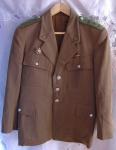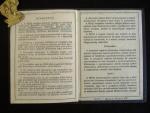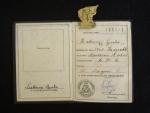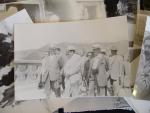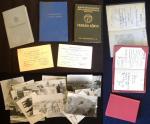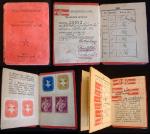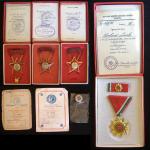-
Posts
2,660 -
Joined
-
Last visited
Content Type
Profiles
Forums
Blogs
Gallery
Events
Store
Everything posted by hunyadi
-

Austria-Hungary Franz Joseph Military Merit Medal
hunyadi replied to Coinguy89's topic in Austro-Hungarian Empire
Looks like a nice original one - but the pics are a bit blurry. Make sure the crown and the medal are tow separate pieces. The medal should be joined by a hinged pin to the crown. Of interst is the red peace time ribbon with the hook device from another ribbon sewin on the back. This was a common practice to sew two tiny loops onto the uniform so that the medal could be hung and easily removed. The other method was sewing a horixontal loop that the ribbon could hang on, but in order to remove the ribbon and the medal one had to separate the ribbon and the medal to do so - a lenghty process and one that was a pain as you had to have the suspension ring within the folds of the ribbon - not hanging down off the back hook. From the stains on the ribbon I would assume that there was another medal worn beofre it when worn as a 'medal bar'. If you paid less than $75 you made out like a bandit. -

Romania Rumanian Order of the Star, 5th Class
hunyadi replied to Riley1965's topic in Central & Eastern European States
Regardless of the RSR period - its still a thing of beauty! Any regulations as to what these were awarded for and who got them? -

Hungarian Royal order of merit
hunyadi replied to Alex K's topic in Central & Eastern European States
First of all - very nice awads! Secondly - the ribbons are correct. Green for the civil and the red for the military during the war. There was also a similar ribbon for peace time military. Green center field and red white outter rim. As for "BG" - that is an unkown mark to me. Mostly you find 'AMAP' with silver content '875' or 'BRONZ' if it was made from a bronze base. 'BG' if its engraved could also be the recipients initials as this has been found on other Knights Crosses. Would it be possible to show the 'BG'? -

Austria-Hungary Civil Version of the Signum Laudis
hunyadi replied to hunyadi's topic in Austro-Hungarian Empire
Well as legend has it he apparnetly spent alot of his time in his chapel praying to God - so if he was a gentile man and kind man could be a possibility, but to the Turks - he was most asuredly bloodthirsty. Now in the Hungarian Military Museum there are two rooms dedicated to, Hunyadi, the Monk (cant remeber his name) and the Battle. In the display is apparently his cloak in relic condition - mohts have certainly taken thier toll on the garment. Soooooo - how about those Peacetime Signum Laudis? -

Hungary Hungarian Partisan History and Research
hunyadi replied to hunyadi's topic in Central & Eastern European States
Just for an update, I have contacted the national archives and have been promised a response within a month...after the sping break I will be meeting with Makai Angnes and Dr Godo again. Still working folks... -
Its not been my month of translation.....
-

Hungary Rare WW2 Hungarian lot
hunyadi replied to hunyadi's topic in Central & Eastern European States
When I thought that I had a nearly complete set... This last weekend was the monthly militaria show and I was looking through a huge box full of photographs tossed in it. While I was not realy looking for any WW2 photos at the time - I picked out of the 'grab bag' this document for the return of Transylvania medal - to my utter surprise it was issued to Mr Varga! Its a nice treat to get another piece of the collection. The guy who had the box of photos (impossible to say if there were more Varga items in them as there were probably a thousnad photogrpahs to look through) threw in the medal as well - not Varga's in all reality - but its a nice item to go with the document. Now if I could find his Southern Hungary medal - that would be great! -

Hungary Munkara, Harcra Kesz (Workers Ready to Fight!)
hunyadi replied to hunyadi's topic in Central & Eastern European States
thanks! -

Hungary Armed Forces Uniforms
hunyadi replied to hunyadi's topic in Central & Eastern European States
-

Hungary Armed Forces Uniforms
hunyadi replied to hunyadi's topic in Central & Eastern European States
Next is a M57 Border Guard tunic for a Master Sgt. (equivalent). The M57 parade tunic used an open collar design with a pip of the serivce branch color along the collar. Serivce and walking out tunics contiuned to use the closed collar design, but with sewn in shoulder boards not like the "slip on" Rakosi era type. The Service and Walking out unifomrs were also converted over to a four pocket design. After 1965 all tunics were converted to the open collar. NCO tunics used silver buttons while and officer would have used brass colored buttons. As this Border Guard fell under the ministry of the Interior they used buttons with the "Kaddar" coat of arms. The military used a crossed rifle button with wreath. The lapel devices are brass and should be silver but thats how I got it. The badge on the upper right pocket is a pre 1956 silver grade "Haditorna" badge. There were holes for a single ribbon bar, the only one I have at the time is a Service Medal - could have also been a flood medal or something else - but its representative. -

Hungary Armed Forces Uniforms
hunyadi replied to hunyadi's topic in Central & Eastern European States
-
As we have some good threads on the civilian uniforms and some of the ones from the 1956 revolution period, I wanted to start a thread where uniforms of the Armed Forces could be posted for reference. These should include Police, Military, Workers Militia, and anyone who was authorised to cary and gun and wear a uniform. To start off with I will post a very new aquisition - a M51 Panzer tunic to a Sgt. Pins are the 1955 April 4th commemorative badge and an MHK sports badge from 1950. The tunic is dated 1953 by the inspection stamp.
-

Hungary HUPR Lots to Individuals
hunyadi replied to hunyadi's topic in Central & Eastern European States
too fast on the keyboard - thanks for the corrections... -

Hungary Munkara, Harcra Kesz (Workers Ready to Fight!)
hunyadi replied to hunyadi's topic in Central & Eastern European States
The pins are about 35mm tall by 23mm wide. (tallest to widest) - So Zsolt - did they all come with 1949 on them or were there examples with other years. It was my understanding from the guy I got these from that the organization ended in 1950? But no one is an "expert" obviously. Here is a shot I forgot with the 'score' levels. My earlier post is incorrect after looking at it again - will ammend... -

Hungary Munkara, Harcra Kesz (Workers Ready to Fight!)
hunyadi replied to hunyadi's topic in Central & Eastern European States
Final page is the regualtions of the organization and the rules regarding the awarding for the pin. There was a Bronze, Silver and Gold grade. I have yet to see a bronze grade yet. -

Hungary Munkara, Harcra Kesz (Workers Ready to Fight!)
hunyadi replied to hunyadi's topic in Central & Eastern European States
From what I can determine the organization had a system of testing twice a year for its members. Testes included: Technical ability, Intelegence, Strecthing ability, Speed, Stamina, Strength, and Theory. A grade of "F" was above average, "K" was average, "A" was passing. Apparnetly he got an initail score of A but this was amended. In his test scores he is given the right to wear the Gold Grade of the Pin. -

Hungary Munkara, Harcra Kesz (Workers Ready to Fight!)
hunyadi replied to hunyadi's topic in Central & Eastern European States
Here is a shot of the first page of the book - and a better shot of the pin itself. There was a part for a photo on the left hand side, but this was never applied. -
This is an interesting organization that I have come across recently. Apparently the organization only exitsted for about a year before disapearing in the Rakosi ear - possibly from purges? This is the first time I have encountered a book for the organization which was designed to encourage members of the working class and the armed forces to engage in sports and education. Interesting as the memebership pins come in two styles, one with a flag bearing the "Tildy" - (Kossuth Coat of Arms) as seen from 1946-mid 1949. And then after the takeover of the Party - pins bear the "Rakosi" coat of arms. At the bottom of the pin is the year 1949. Presumably there would have been pins with the year of entry to membership but "1950" I have never encountered.
-

Hungary HUPR Lots to Individuals
hunyadi replied to hunyadi's topic in Central & Eastern European States
Here is a clear shot of the Ministers from left to right. Interior Minister Munhich Ferenc, Kultural Minister Ach Gyurgy, Foreign Minister Sila Ferenc. (may not have a perfect spelling of those names) -

Hungary HUPR Lots to Individuals
hunyadi replied to hunyadi's topic in Central & Eastern European States
Forstner was a member of several organizations. In the lot are also two more Party books well into the 1970's. In the lower section are the photos of the trip to China. -

Hungary HUPR Lots to Individuals
hunyadi replied to hunyadi's topic in Central & Eastern European States
Of interest is also the not so often encountered Communist Hungarian Party book from 1945. By November of 1945 the Party had only about 80,000 memebrs. As a result they were not able to carry the 1945 election loosing terribly to the Smallholders Party - but Stalin intervened with the Allied Control Commission and dictated that the Communist paryt would hold all the important positions in the government. -
As several lots have appeard but are buried under layers of another thread I would like to start a thread that deals specificlay with a collection of awards, docuements, regalia, etc...to individuals boths civil and military. To start with I will post this compelation that I got a little while ago. Forstner Laszlo was born on Dec 31st 1914 and was an early member of the Communist Hungarian Party. As a result he made some very imposrtant friends in the party. He had relations with the Minister of the Interior, the Cultural Minister and the Foreign Minister during the 1960's and 1970's. As a result he was invited to attend a foreign mission to China in the 1970's. He was with the delegation and took several photos. First off are his Kivalo Dolgozol badges (3) from 1969,1970 and 1971. He also was awarded the Jubilee Medal being the 98th recipient according to his serial number.
-

Austria-Hungary Civil Version of the Signum Laudis
hunyadi replied to hunyadi's topic in Austro-Hungarian Empire
Janos Hunyadi was the defender of Belgrade in 1456 - so that makes him a 15th Century...my mind was on the battle of Eger in 1552...when I said 16th Century. Anyhow - Hunyadi felt that it was his God ordained mission in life to defend Europe from the Turkish empire. Besieged in Belgrade with only 20,000 troops and the civilian population he had requested help from Rome to stop the advance and break the seige. The Vatican was apparently a little too busy and sent a solitary monk as "assistance" - apparently the story goes that early in the morning some eager defenders on their own initiative stormed out of the gates and began to assault the Turks who were still mostly sleeping in their tents. A fierce skirmish ensued which quickly turnd into a battle. As legend has it the monk sent by Rome was caught up in the fury of the initial skirmish and proclaimed "whatever God has started, who are we to intervene?" (IE - "lets go men!") Hunyadi had not ordered the attack but himslef gathered the remaining troops and pressed the assualt. By the end of the battle the Turks had eitehr died or turned tail and ran. The Sultan in charge retreated and gave Hunyadi his honors. The Turkish army had numbered about 150,000. When I think of the battle I think of the battle scene of "Helms Deep" from Lord of the Rings. After the battle the Pope declared that all church bells would be rung at noon to celebrate the victory in Belgade "untill the return of Chirst". To this day the Catholic Church continues to ring the bell at noon and in certain places every hour as it became a great way of telling the villagers what time it was. Sadly Hunyadi died of the Black Plague shortly after his victory. Hunyadi was not truly Hungarian, but rather a Serb who had married a Hungarian princess. As he was from the southern portion of Hungary, The Regent Admiral Miklos Horhty when he joined Hitler in the Balkan campaign of 1941 in return for the reaquisition of a portion of the Historical Hungary created the medal with the image of Hunyadi on horseback (my avitar is the medal) Then in 1944 when the SS formed the Hungarian Volunteer SS dividison they named it the Hunyadi division and the collar tab was black with a embroidered "H" for "Hunyadi" (Not Hungary as that would have been "U" Ungarn and the Hungarians do not call themselves Hungarians but "Magyar" as they are decendants of the tribes of Magyar - 'Hungary' is actualy a mistake made by Papal missionaries to the region who labeled the people as 'Huns' thinking they were similar to the Germanic tribes.) I think also the imagry of the 1456 Hunyadi played well into the 1944 Hunyadi as being a force that could defeat overwhelming odds. As I understand the SS Hunyadi dividison never saw combat as a formation. Of other interst almost exactly 500 years after the Battle of Belgrade - another battle raged, but this time in the capitol of Hungary in a similar David and Goliath battle (Hungarians vs the Soviets). -

Hungary Congratulations Hunyadi!
hunyadi replied to Ulsterman's topic in Central & Eastern European States
Ed - if it makes you feel any better - I dont even have a copy of the final edit. The one they sent, I had to mark it up for mistakes and send it back. They did promise to send me a complimentary copy for which I eagerly await. Now to go about and get copies for the family??? -

Hungary Hungarian Firemen's Medals
hunyadi replied to Gordon Craig's topic in Central & Eastern European States
Well - I got out the calipers and got a selection of what I know to be from the 1949-56 period. Nearly all these ribbons are about 43-44mm in width - again I did not measure edges as the folding gets them out to be in various sizes! (I measured the 'raw' ribbon only) The post 1956 ribbons are about 40mm in width. For my confusion - the "Large Hungarian Medal Book" lists nearly every ribbon from 1946 to 1989 as a "40mm wide trifold"...once again - thanks Zsolt for your wealth of knowledge!





